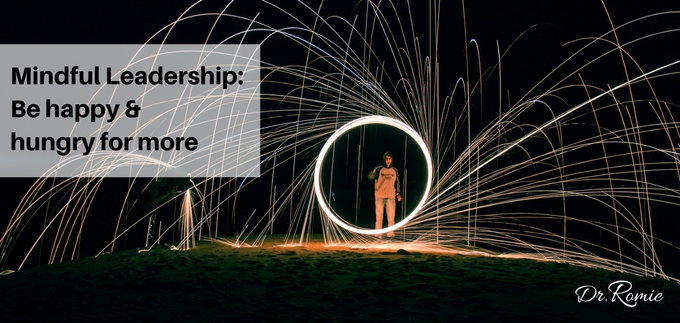Stress-Success-Stress Again
Welcome to the brain’s stress-success cycle. It is human nature to want to achieve goals, acquire things, titles, and find meaningful relationships. We set a goal and may experience stress to stretch to a new goal. Goal met. Happiness, but then the happiness fades. Wait what happened to inner peace?
Maybe if you just accomplish one more thing…
This is the stress-success-stress again cycle. We can end up perpetuating a chase for that happy feeling while ignoring what the mind needs.
Retraining The Brain for True Happiness
As both a brain doctor and mindfulness advocate, I am not going to dismiss the human need and desire to set goals and achieve them. There is a bad rap in the “real world” about the spiritual world or mindful movement saying we must denounce worldly pleasures.
The real answer is, are you connected to a source of inner happiness or joy that does not revolve around setting a goal, achieving it, and then setting another goal that brings on more stress. At some point, we may stop and realize, I have accomplished all of my life dreams, but when will I ever be happy?
Mindful Leadership: Keeping the Brain and Business in Peak Performance
I travel the country teaching the brain science behind mindfulness and meditation for leadership and stress management to companies, associations, and universities. One of the typical questions or resistance I hear has to do with that notion of that mindful world does not allow for setting goals and celebrating the achievement. Mindful leadership and present-centered awareness does not mean that we are detached from a desire for success. Mindfulness teaches us to be happy now and hungry for more.
Mindful Solution to Living in the Western World
In his book The Upward Spiral, neuroscientist Alex Korb explains the intricate brain processes that cause depression. here are four simple rituals we can all start today to rewire our brains to be happy.
What are the four secrets to wire your brain for happiness?
There is a myth that happy people are happy all the time. Happiness is not an emotion or personality trait that exists 24/7, but rather a state of mind that can be achieved.
Depression can feel like a downward spiral, and pulling out of a blue state may feel impossible. In his new book The Upward Spiral, neuroscientist Alex Korb explains the intricate brain processes that cause depression. There are four simple rituals you can start today to rewire your brain to be happy.
GLASS HALF FULL OR HALF EMPTY?
It is often thought if you were born unhappy, a glass half empty kind of person you can’t change, is this true?
As brain science advances one thing has become clear in the last decade, the brain can change “or rewire” in the way it functions and is structured depending how the brain is trained and stimulated.
When it comes to unlocking the secret behind happiness, it is not as big of a mystery as we think. There are four rituals that have been proven in neuroscience to rewire our brains to see the glass half full and to feel happy.
4 STEPS TO TRAIN YOUR BRAIN FOR HAPPINESS
What are the rituals people can practice to learn to be happy?
STEP 1. The first step is to adopt an attitude of gratitude.
Happier people practice daily rituals of expressing gratitude.
Try it. Name three things you are grateful for right now. Scientific studies show it elevates dopamine in the brain stem- part of the reward system of the brain. Being thankful also boosts serotonin level. These are all the “feel good” chemicals in the brain that boost happiness naturally.
STEP 2. The second step is to name your emotion, even if it is negative.
A key principle in spiritual psychology is, “what we resist persists.” If you are feeling bad, state it. When you put feelings into words, you distance yourself away from those feelings. Detaching yourself from negative feelings helps your brain to detach from the emotional loop that starts ruminating and gets lost in a spiral of dark emotions.
STEP 3. Make a decision.
Indecisiveness and second-guessing yourself will fuel negative feelings of anxiety. Understand there is never such a thing as the perfect decision. Don’t get stuck in trying to make the absolute 100% best decision. We all know being a perfectionist can be stressful. And brain studies back this up. Trying to make a perfect decision can lead to procrastination. Instead, make a “good enough” decision, this is the best possible decision you think is right at the moment.
Eastern spiritual wisdom teaches us the first instinct is usually the correct instinct.
STEP 4. One of the rituals is about human touch, how can this make us happier people?
Humans need to feel love and accepted by people, and when we don’t feel a sensation of love, it is painful. The brain registers a lack of touch or love and severe pain.
Touching is incredibly powerful. We just don’t give it enough credit. It makes you more persuasive, increases team performance, improves your flirting. (a skill useful for all of us single gals). Touching releases a potent hormone called oxytocin that fuels happiness.
LET US HOLD HANDS TOGETHER ON THE PATH TO HAPPINESS
Last but not least, remember we must slow down to speed up. A path to happiness is not a sprint, but training for a marathon.
Start by telling me, what are three things you are thankful for today? Post below and I hold an intention of happiness for you on your journey.
Doing a happy dance with you and for you,
Dr. Romie
